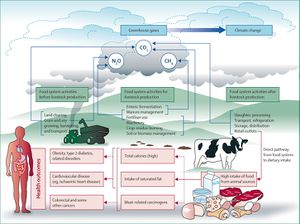Food and agriculture related climate and health impacts
Jump to navigation
Jump to search
[[Category: ]]
| Moderator:Miranda Loh (see all) |
|
|
| Upload data
|
Based on the assessment done in Friel S et al. 2009. Public health benefits of strategies to reduce greenhouse gas emissions: food and agriculture. Health and Climate Series 4, The Lancet. [1]
Scope
Purpose
Describe strategies that would allow the food and agricultural sector to meet the targets recommended by the UK Committee on Climate change and quantify these strategies' main effects on health.
Boundaries
Spatial:
- UK
- Sao Paulo, Brazil
Temporal:
- Baseline = 2010
- Future projection = 2030
Population: Adult
Policy strategies:
- Improve efficiency of livestock farming
- Increase carbon capture through management of land use
- Improve manure management
- Decrease dependence on fossil fuel inputs
Scenarios
For UK:
- Strategy one: technological change
- Includes increased efficiency, new technologies, improved farm management
- Estimated reduction of 5 MtCO2e contribution to achieving 2020 emissions reduction target with 80% attributed to livestock
- Expected reductions of 8 MtCO2e from 2007-2030 (emission from livestock sector to be reduced from 36 to 28 MtCO2e
- Strategy two: technological change + reduced livestock production
- This strategy would cover the 6 MtCO2e gap between the 28 MtCO2e from Strategy one and the target 22 MtCO2e which would meet the required reduction of emissions
- Includes 10% growth in demand for livestock products due to population increase
- Reduction of livestock production and consumption of foods from animal sources by 30% by 2030
Intended users
Participants
Definition

Decision variables
- UK technological change to reduce emissions in agriculture
- UK technological change and reduced livestock production
- Reduction in dietary intake of saturated fat and cholesterol from animal sources
Indicators
- Health outcomes from:
- Dietary intake of saturated fate (DALYs, YLL, premature deaths)
- Serum cholesterol concentrations (YLL, premature deaths)
- Agricuture sector greenhouse gas emissions
Value variables
Other variables
- Animal source saturated fat intake
- Dietary chlesterol intake
- Serum cholesterol concentrations
- Livestock production
- Hazard ratio for dietary intake of saturated fat and disability from ischaemic heart disease > 35 years age
- Hazard ratio for dietary intake of saturated fat and death from ischaemic heart disease > 35 years age
- Hazard ratio for serum cholesterol concentration and death from ischaemic heart disease
- Stroke burden of diesease
Analyses
Comparative risk assessment
Indices
- Age and gender UK
- Age and gender Sao Paulo